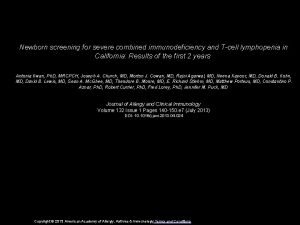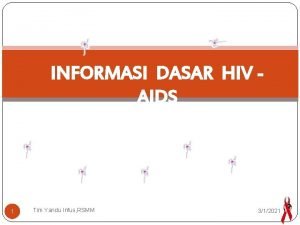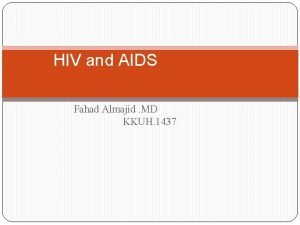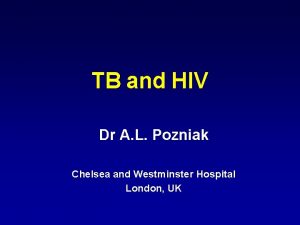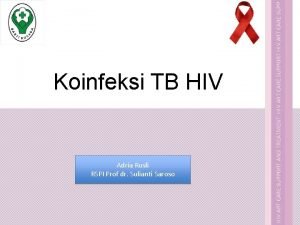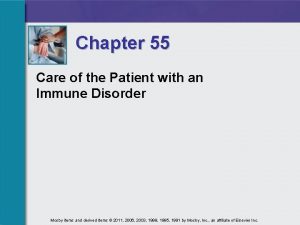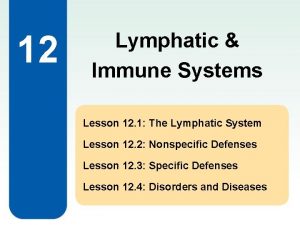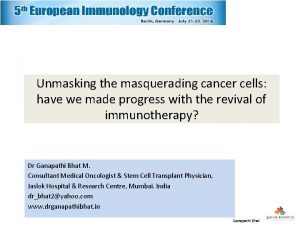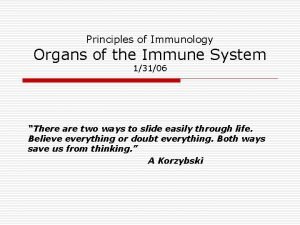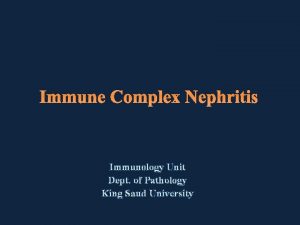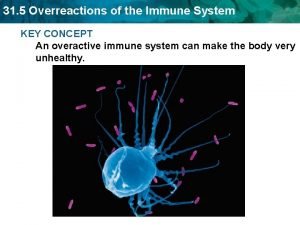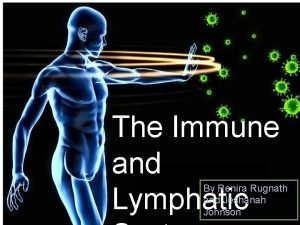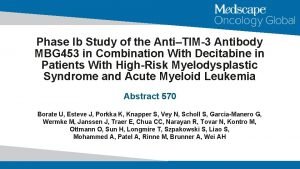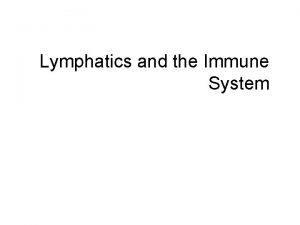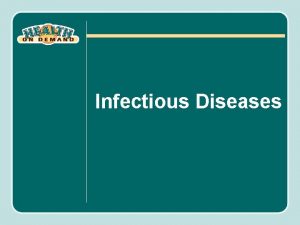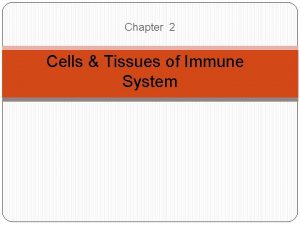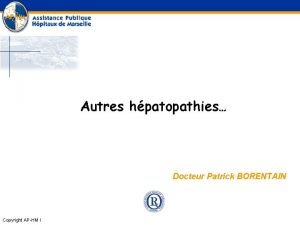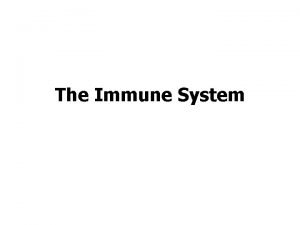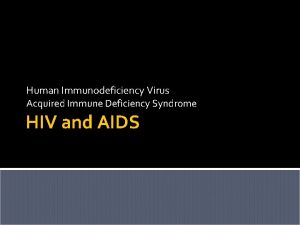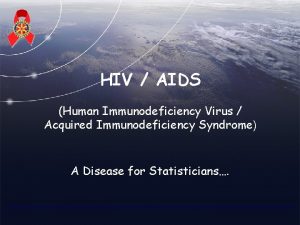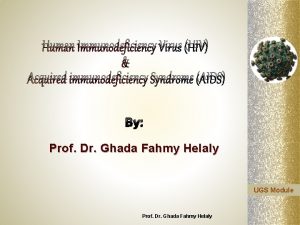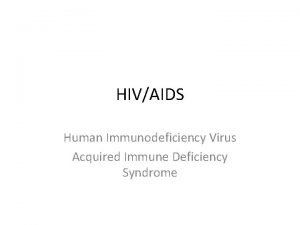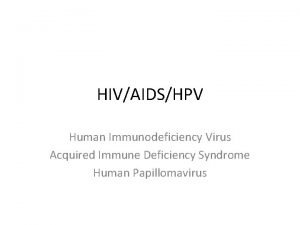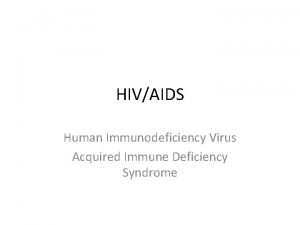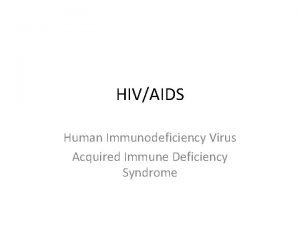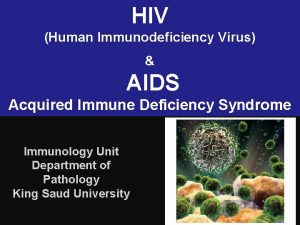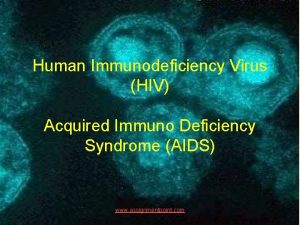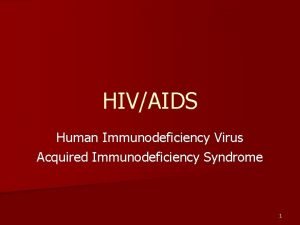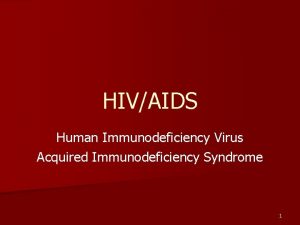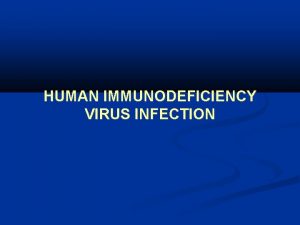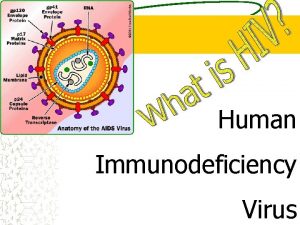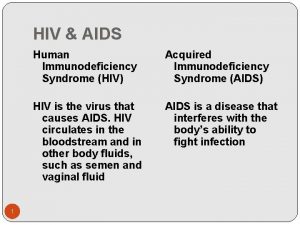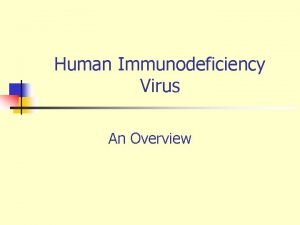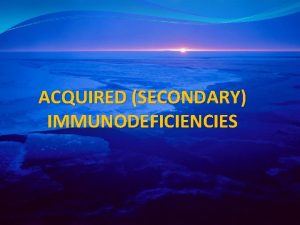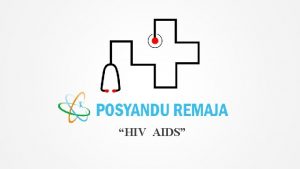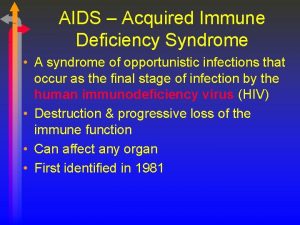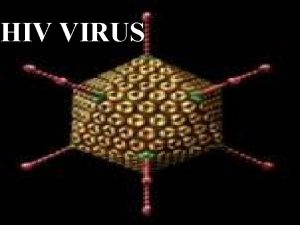Human Immunodeficiency Virus HIV Acquired Immune Deficiency Syndrome

































- Slides: 33

Human Immunodeficiency Virus (HIV) & Acquired Immune Deficiency Syndrome (AIDS) Prepared by: Dr. Amany Ballow Consultant Immunology

Objectives To understand : v The modes of transmission of HIV v HIV interactions with CD 4 positive helper lymphocytes v Mechanisms involved in immunodeficiency associated with HIV v the course of immunological events from the time of infection with HIV until the development of AIDS

What is AIDS • HIV is the virus that causes AIDS • Is the final Stage of HIV infection. • when the Immune system CD 4 cells drop to a very low level, person’s ability to fight infection is lost

Human Immunodeficiency Virus (HIV) v HIV belongs to a group of retroviruses called lenti-viruses. v. The genome of retroviruses is made of RNA (ribonucleic acid), and each virus has two single chains of RNA v for replication, the virus needs a host cell, and the RNA must first be transcribed into DNA (deoxyribonucleic acid), which is done with the enzyme reverse transcriptase. v. HIV infects mainly the CD 4+ lymphocytes, but also to a lesser degree monocytes, macrophages, and dendritic cells. v. Once infected, the cell turns into an HIV-replicating cell and loses its function in the human immune system v HIV is a lentivirus that causes HIV infection and over time acquired immunodeficiency syndrome (AIDS)

HIV


How HIV Enters Cells • gp 120 env protein binds to CD 4 molecule • CD 4 found on T-cells macrophages, and microglial cells • Binding to CD 4 is not sufficient for entry • gp 120 env protein binds to co-receptor • Chemokine receptors: • CCR 5 and CXCR 4 receptors • Binding of virus to cell surface results in fusion of viral envelope with cell membrane • Viral core is released into cell cytoplasm.

HIV and Cellular Receptors This picture shows HIV’s attachment and entry into a host cell. • gp-120 protein attaches to a CD 4 receptor. • gp-41 is exposed for attachment to the host cell, and fusion of the cell membrane with the viral envelope starts.

How HIV infect CD 4 cells


Adaptive Immune response • The adaptive immune response is divided into two types: 1 -Cell-mediated (cytotoxic t-cell) type 2 -Humoral (antibody-mediated) type. • In general, the location of the infection (intracellular or extracellular) determines the type of adaptive immune response. • Intracellular infections stimulate a cell-mediated response that will ultimately kill the infected cell. This is mediated by T 8 cells, and utilizes the MHC I system. • Extracellular infections stimulate a humoral response that will help contain these free antigens. Some extracellular antigens will be picked up by APC and be presented by way of MHC-II to the TH cell, which will further differentiate into either TH 1 or TH 2. • TH 1 in turn will augment the cell-mediated response and Th 2 augments the humoral.

Natural history of infection

HIV infection stages There are three stages of HIV infection: • Acute HIV Infection • Chronic HIV Infection • AIDS

1 -Acute HIV Infection • Is the earliest stage of HIV. • Generally develops within 2 to 4 weeks after a person is infected with HIV. • During acute HIV infection, many people have flu-like symptoms, such as fever, headache, and rash, cervical lymphadenopathy, aseptic meningitis, encephalitis, myelitis, polyneuritis. In this acute stage of infection: • HIV multiplies rapidly and spreads throughout the body. • The virus attacks and destroys the infection-fighting CD 4 cells of the immune system. • HIV can be transmitted during any stage of infection, but the risk is greatest during acute HIV infection.

1 -Acute HIV Infection • (1 to 3 months): After infection, there is in general a first peak in HIV RNA copies and a steep decline in CD 4 (300 -400) cells in the blood. • These changes can be explained by the fact that during the early days, HIV can replicate without being controlled by the immune system (viral RNA copies to >1 million). • 70 -80% symptomatic (3 -12) weeks after exposure • When the body's anti-HIV immune response begins (antibody responses begin to develop 4 to 8 weeks after infection), symptoms of sero-conversion may develop and viral load falls. • Recovery in 7 -14 days

1 -Acute infection • The window period begins at the time of infection and can last 4 to 8 weeks. • During this period, a person is infected, infectious and viremic, with a high viral load and a negative HIV antibody test. • The point when the HIV antibody test becomes positive is called the point of seroconversion

1 -Acute HIV infection Sero-cversion Median 8 weeks after infection. Level of viral load post sero-conversion correlates with risk of progression of disease Asymptomatic Phase Remain well with no evidence of HIV disease except for generalized lymphadenopathy Fall of CD 4 count by about 50 -150 cells per.

1 -Acute HIV infection • The majority of all mucosal CD 4 T lymphocytes are lost, especially in the gastrointestinal tract (GIT). • Infection is associated with increased permeability of the GIT leading to increased circulating lipopolysaccharide (LPS) levels, a component of the cell wall of Gram-negative bacteria in the GIT. • The circulating LPS cause chronic immune activation in a non-specific way. • The chronic immune activation causes higher susceptibility to HIV because HIV needs activated CD 4 T cells for replication.

2 -Chronic HIV Infection • The second stage of HIV infection is chronic HIV infection (also called asymptomatic HIV infection or clinical latency). • During this stage of the disease, HIV continues to multiply in the body but at very low levels. • People with chronic HIV infection may not have any HIV-related symptoms, but they can still spread HIV to others. • Without treatment with HIV medicines, chronic HIV infection usually advances to AIDS in 10 to 12 years.

2 -Chronic HIV Infection • On average 8 -10 years, without antiretroviral treatment • After the acute infection phase, CD 4 cell concentration in the peripheral blood increases again, although not as high as before infection. • HIV RNA copy number in the plasma declines again, and the stabilized plasma concentration after the peak of the primary infection is called the viral set-point.

3 -AIDS • AIDS is the final stage of HIV infection. • Because HIV has destroyed the immune system, the body can’t fight off opportunistic infections and cancer. • AIDS is diagnosed when a person with HIV has a CD 4 count of less than 200 cells/mm 3 and/or one or more opportunistic infections.

3 -AIDS • HIV gradually disrupts the immune system, kills the CD 4 lymphocytes, and throws the immune system out of balance. • HIV also destroys the immune system's memory. CD 4 cells, which have been programmed to recognize infections, become depleted. • For this reason opportunistic infections such as TB, candida, and others can develop when the CD 4 count falls low. • On average 2 -3 years, without antiretroviral treatment: The third phase is characterized by a rapid increase in HIV RNA copies and a decline in CD 4 cell counts in peripheral blood


Mechanisms of CD 4 Depletion and Dysfunction • Direct • Elimination of HIV-infected cells by virus-specific immune responses • Loss of plasma membrane integrity because of viral budding • Indirect • Syncytium formation • Apoptosis • Autoimmunity

Syncytium Formation • Observed in HIV infection, most commonly in the brain • Uninfected cells may then bind to infected cells due to viral gp 120 • This results in fusion of the cell membranes and subsequent syncytium formation. • These syncytia are highly unstable and die quickly

Role of Cellular Activation in Pathogenesis of HIV • HIV induces immune activation • Which may seem paradoxical because HIV ultimately results in severe immunosuppression • Activated T-cells support HIV replication • Inter-current infections are associated with transient increases in viremia • Accounts for why TB worsens underlying HIV disease

Role of Cytokine Dys-regulation in Pathogenesis of HIV v HIV is associated with increased expression of pro-inflammatory cytokines �TNF-alpha, IL-1, IL-6, IL-10, IFN-gamma v HIV results in disruption and loss of immuno-regulatory cytokines �IL-2, IL-12 �Necessary for modulating effective cell-mediated immune responses (CTLs and NK cells)

CD 4 T-cell Count and Progression to AIDS • Gradual reduction in number of circulating CD 4 cells is inversely correlated with the viral load • Any depletion in numbers of CD 4 cells renders the body susceptible to opportunistic infections

Laboratory Markers of HIV Infection • Viral load • Marker of HIV replication rate • CD 4 count • Marker of immunologic damage

Diagnosis v Antibody test, Screening test v ELISA Western blot (protein immunoblot) Confirmatory test. Confirm the presence of Ab and help to diagnose the condition Used to detect specific protein using gel electrophoresis v HIV RNA viral load (PCR) Nucliec Acid Amplification Testing (NAAT)

Management Treatment recommended when symptomatic or CD 4 count below 200. v Earlier if high viral load, rapidly falling CD 4 count, hepatitis C co-infection. v v Ant-iviral therapy Ø Reverse transcriptase inhibitors Ø Protease inhibitors Ø Fusion inhibitors

Take Home Message • Infection with HIV usually occurs by sexual transmission, blood transfusion, mother to infant or accidental exposure • HIV targets the immune system and primarily infects CD 4 positive lymphocytes • Immunodeficiency associated with HIV infections is mainly due to reduction in CD 4 positive helper lymphocyte numbers • Increased viral load, significant reduction in CD 4 lymphocytes and opportunistic infections are the hallmarks of progression to AIDS

Thanks
 A subsequent
A subsequent What are deficiency
What are deficiency Severe combined immunodeficiency
Severe combined immunodeficiency Stadium hiv menurut who
Stadium hiv menurut who Hiv virus
Hiv virus Immune reconstitution inflammatory syndrome
Immune reconstitution inflammatory syndrome Predeksihkhariini
Predeksihkhariini What is the third line of defense in the immune system
What is the third line of defense in the immune system Flow chart of wbc
Flow chart of wbc Third line of defense immune system
Third line of defense immune system Hydrops fetalis
Hydrops fetalis Difference between innate and learned behavior
Difference between innate and learned behavior Second line of defense immune system
Second line of defense immune system Chapter 35 immune system and disease
Chapter 35 immune system and disease Chapter 55 care of the patient with an immune disorder
Chapter 55 care of the patient with an immune disorder 1st 2nd and 3rd line of defense immune system
1st 2nd and 3rd line of defense immune system Ap biology immune system
Ap biology immune system Chapter 24 the immune and lymphatic systems and cancer
Chapter 24 the immune and lymphatic systems and cancer Lesson 12 blood and immune system
Lesson 12 blood and immune system Lesson 12 blood and immune system
Lesson 12 blood and immune system Immune checkpoint inhibitors mechanism of action
Immune checkpoint inhibitors mechanism of action Immune system lymph nodes
Immune system lymph nodes Immune cells meaning
Immune cells meaning Immune complex glomerulonephritis
Immune complex glomerulonephritis Overreactions of the immune system
Overreactions of the immune system Lymphatic vs immune system
Lymphatic vs immune system Mbg453
Mbg453 Lymphatic vs immune system
Lymphatic vs immune system Defination of immune system
Defination of immune system Primary immune response
Primary immune response Immune effector cells
Immune effector cells Unsaturated alcohol crossword clue
Unsaturated alcohol crossword clue Dr patrick kormann
Dr patrick kormann Antigen defintion
Antigen defintion


